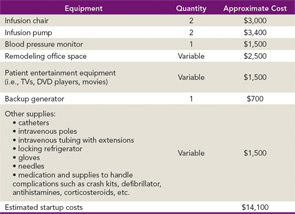The increased utilization of infusible biologics for the treatment of rheumatic diseases has opened the door for you to provide more integrated care for your patients. Having an in-office infusion center gives you the ability to deliver this service to your patients in a familiar and supportive setting, allowing you to direct the administration of the treatment rather than referring patients to the hospital. Another benefit of an onsite infusion center is increased patient adherence with medications and therapy. In addition, there is greater opportunity for patient interaction and education, which can strengthen the doctor–patient relationship.
The process of operating an efficient infusion center involves creating an overall management strategy to evaluate areas such as staffing, general coding and billing, reimbursement methodologies, and financial obligations. The approximate start-up cost for an infusion center can range from $10,000–$15,000. Table 1 demonstrates an abridged list of necessary equipment and supplies you will need for your infusion center, along with approximate costs.
There are fixed costs, such as space rental, staff salaries, and healthcare benefits, which you will have to include with your start-up costs because these tend to make up a large part of practice management expenses. The cost of equipment can vary depending on vendors, so starting off on a smaller scale can usually keep costs in line with your budget.
Staff Requirements
Establishing an onsite infusion center may require hiring additional staff or training current staff members because you will need staff such as nurse practitioners, registered nurses, and physician assistants qualified to administer infusible drugs. Verify state licensure requirements for your health professional staff to work in the infusion center as state requirements vary. Additionally, staffing requirements can differ depending on how many patients your practice will infuse at the same time.
Billing for Infusion Drugs
There are two methods for obtaining medication for your infusion clinic. First, infusion medication can be acquired through the “buy and bill” plan under a patient’s healthcare plan. To use this method, you will have to establish an account with a wholesaler for specialty medication and purchase the drug from the vendor. Then you would bill the patient’s insurance plan. The second option, “assignment of benefits,” is typically covered under a patient’s prescription drug plan but requires preauthorization. This option necessitates using a specialty pharmacy to ship specific doses of medication for individual patients. Under this arrangement, the specialty pharmacy usually handles verifying patient insurance information and bills the patient for any copayment.


